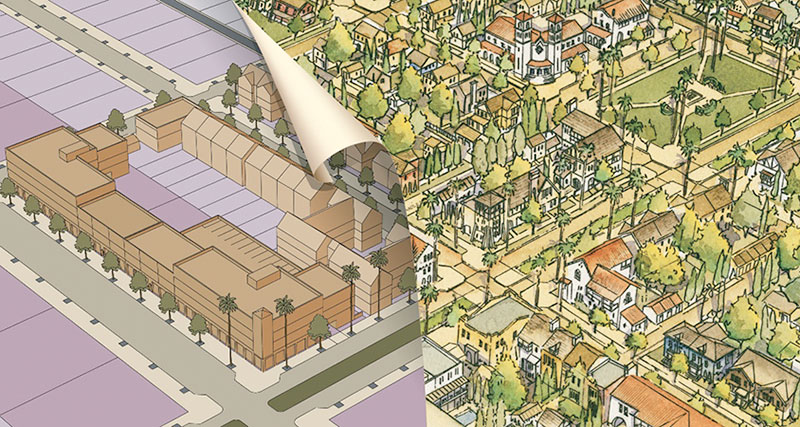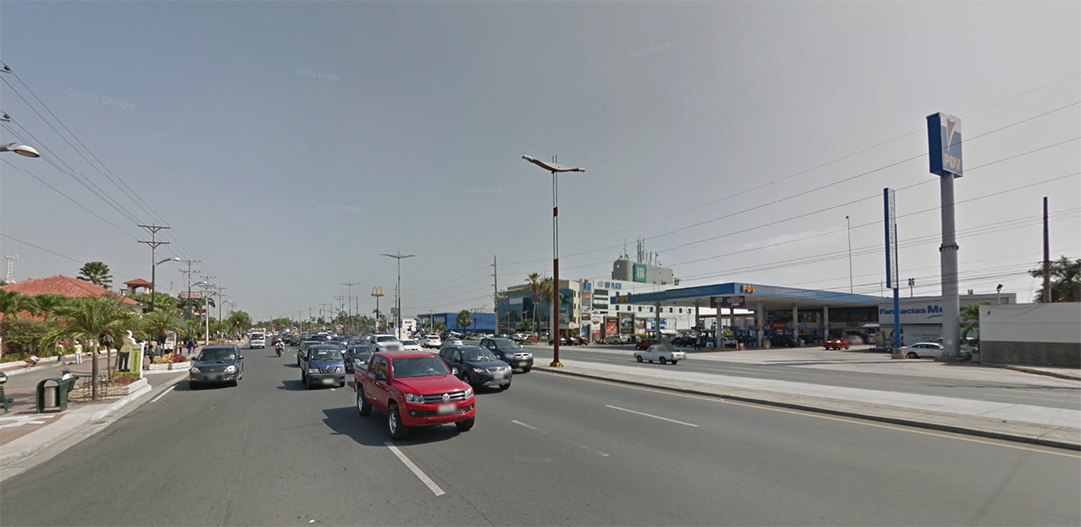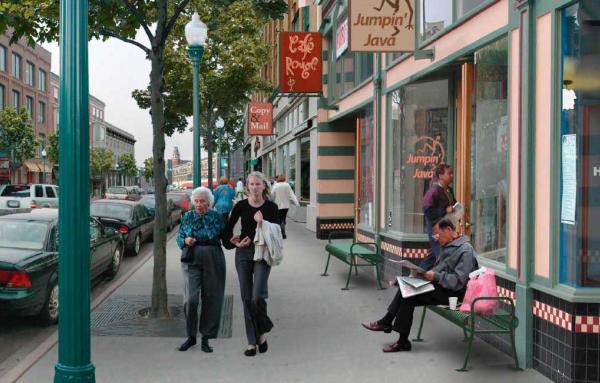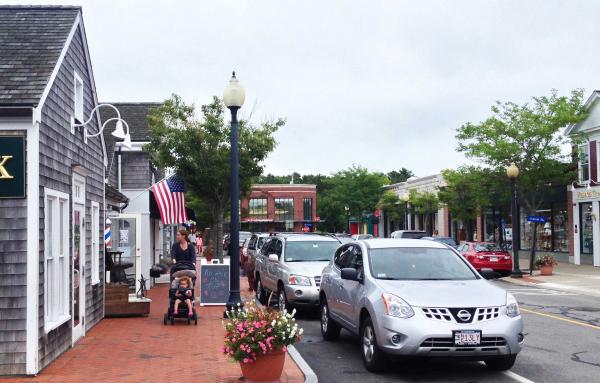
Great idea: Charter of the New Urbanism
In celebration of the upcoming CNU 25.Seattle, Public Square is running the series 25 Great Ideas of the New Urbanism. These ideas have been shaped by new urbanists and continue to influence cities, towns, and suburbs. The series is meant to inspire and challenge those working toward complete communities in the next quarter century.
The Charter of the New Urbanism, adopted and signed in 1996 by attendees of the fourth Congress for the New Urbanism in Charleston, South Carolina, is the foundational text of the New Urbanism. In just over 1,100 words including a preamble, the Charter lays out 27 principles for design of complete communities, from the scale of an individual building, block, or street to an entire city or region.
Five decades and two generations into America's "suburban experiment," planning and development ideas that were exported worldwide, CNU proposed a comprehensive alternative to automobile-oriented, single-use sprawl and deteriorating traditional cities and towns. "We advocate the restructuring of public policy and development practices to support the following principles: neighborhoods should be diverse in use and population; communities should be designed for the pedestrian and transit as well as the car; cities and towns should be shaped by physically defined and universally accessible public spaces and community institutions; urban places should be framed by architecture and landscape design that celebrate local history, climate, ecology, and building practice," says the the Charter preamble.
The Charter champions the opposite of fragmented sprawl. The vision was radical at a time when the land use planning and development industries—including roads, building, finance, and design—were geared toward conventional suburban design. In more than two decades, the Charter has not changed—yet planning and development have moved steadily toward the Charter view of the world. The document speaks to new generations of urbanists—just as it appealed to more than 260 original signers. Two books have been published on the Charter, a first edition in 1999 and a second edition in 2013, with essays that explore in detail what the document means. The influential Charter Awards of CNU have, since 2001, honored planning and development projects that meet Charter principles.
Public Square editor Robert Steuteville interviewed Elizabeth Moule, principal of Moule & Polyzoides Architects and Urbanists, a founder of CNU and one of the authors of the Charter, and Emily Talen, professor of urbanism at the University of Chicago and editor of the book Charter of the New Urbanism, Second Edition, on the The Charter of the New Urbanism, how it has shaped cities and towns, and whether it needs to be updated.

Why a charter? Why did the CNU create it?
Moule: It's important to start with a bit of history—the principles of the Charter grew out of the Ahwahnee Principles that were written for the Local Government Commission in the State of California. These were written by Stefanos (Polyzoides) and I, Peter (Calthorpe), Andres (Duany), and Lizz (Plater-Zyberk), with the help of Michael Corbett. They're almost identical to the principles of the Charter and they were its source.
These principles were drafted because there was a need for a set of fairly straightforward guidelines that at the same time were holistic. They had to cover the buildings, block, street, neighborhood, district, and region. The idea was to create something that was not only a source of agreement among urbanists, but something that had the power to be generative. We wanted to allow other people to use them and carry on with remaking the physical world.

Talen: It’s an affirmation of the validity of these principles that historically they were employed outside the realm of our current reality. Liz and the other folks who wrote the Charter were aware of concepts like Garden Cities, street connectedness, and the importance of bounding settlements to prevent sprawl. These ideas were once hard-wired into the planning and design of cities. It's cool that this group of people in California were able to draw on that historical knowledge, then update it and refine it to a manageable set of principles.
Moule: There’s definitely a perception that for millennia cities were designed according to common sense but somehow it had all gone awry in the 20th Century. We humans found a way to get around these hardwired principles and do something nonsensical.
I have never personally heard anyone disagree with these principles, even those who may say that they strongly disagree with the New Urbanism itself. Yet these principles aren't entirely vague, as they lead to cohesive places or certain types of places. How come there is so much agreement on the principles and, yet, not so much agreement on the New Urbanism?
Talen: The best analogy is with the US Constitution. We all rally around the Constitution but when you get to the point of implementing and interpreting the principles in reality, that's when all the arguments start. But that's healthy. I think that the Charter is so valuable because it's found the right level of specificity that allows alternative implementations. When people criticize New Urbanism, it’s usually certain implementations of these principles that are disliked. I'm a critic of a lot of New Urbanism. Every day we see the half-baked application of principles. Often, I think some of these principles that are laid out haven't been taken seriously enough. But if a project doesn't take the principles far enough, at least these were the aspirations they tried for.
Moule: It's important to distinguish between design principles that are in the Charter and specific design solutions. We made design principles, as opposed to solutions, so they could be interpreted contextually, regionally, locally in so many different versions, according to what was appropriate as a solution. A lot of the critique of New Urbanism itself or New Urbanist projects comes from a lack of quality and sometimes high design. But those criticisms can be leveled on projects across the board, whether New Urbanist or not. Inasmuch as we set a high standard for ourselves, a lot of people believe that that standard should also include very high-quality, well-capitalized projects built for millennial standards. In other words, that we don't build a lot, but we build it well and it lasts for a long time. And I think that people are right to critique New Urbanist projects that don't comport with that.
One thought is that no particular project can meet all the principles of the Charter. Sometimes people expect you to meet all 27 principles, especially if you’ve espoused them in a charter, but this is really a set of principles that's supposed to govern multiple projects that come together as a whole place. Another thought is this: just like there's various quality of sprawl, there’s various quality of urbanism. How can there not be? Many different developers and designers follow the principles of the Charter, whether they know it or not.
Moule: I don't think that perfect should be the enemy of the good, and frankly perfect isn’t necessarily possible when you're talking about urbanism. There is a lot of diversity, but I think that urbanists embrace diversity, whereas people who support urban sprawl are conventional modernists, and they don't care for that diversity.
Talen: This is an age-old problem in city planning that’s existed for more than a century. Supporters of the Garden City said, "We have to have complete Garden Cities or else it's not a Garden City. It has to have a form of employment and it has to be on transit." We have these kind of debates in New Urbanism too. Some people think if you make exceptions for projects that don’t espouse the entire concept, then you enable mediocrity and it’s not necessarily a step in the right direction. How strict are we supposed to be about these 27 principles? I think the value of the principles is that they state a position and form a platform.
Moule: New Urbanists recognize that cities are currently evolving, at least in the United States. Hopefully, it's an arc towards improvement over time. When someone builds a project with a New Urbanist intent, even if it doesn’t possess all the elements, it remains somewhat open-ended. It's not a fixed object that’s unable to accommodate transformation in the future. It can be improved. Instead of thinking about these places as final outcomes, we can think about them as incremental steps towards something better.
Is this clear set of principles a defining aspect of the New Urbanism?
Moule: I think it's the very essence of New Urbanism.
Talen: But it's also a blessing and a curse. The principles are great in that they pull together the best aspects of historical city planning, but for some people, they see them as ideological and that makes them uncomfortable. For them, it’s dogma. But on the flip side, I think that energizes constant debate and exchange within the New Urbanism. There is a focus on empirical evidence and a commitment to bottom-up engagement like the charrette process that counterbalances this top-down manifesto. The techniques might be constantly changing but there is a solid set of principles to refer back to. I like how the New Urbanism is not relative. In certain worlds, that's perceived as a very conservative position but through constant debate, empirical research, and community engagement concerning our practices, we push back against the potential negatives associated with a clear set of principles.
Moule: The principles of New Urbanism are far from a constraint on creativity. They aren’t shackled to some predetermined outcome nor do they tie the hands of the architect or the planner as a maker. It's important to remember that the New Urbanist principles were a critique of suburban sprawl and zoning, a replacement to generate superior places. Superior places require an assessment of the needs of a broad spectrum of people, the individual stakeholders. The principles are absolutely not relative, but they’re highly contextual. A lot of people would call that ironic, but I think that's the best way to put it.

Talen: We need to be honest that there are some constraints here; the principles don’t allow for complete design license. But they do expose the values laden in particular design decisions and make them clear. Architecture, design, and even city planning privilege certain values, such as everyone should own a car or homogenous suburban development is the only place to raise a family. It’s important to be able to identify the values that underlie all design principles.
Moule: I have also described the principles of the New Urbanism as a value system. At the same time, CNU is not prescriptive about character, style, or innovation, the sorts of things that come into play as we make places. For New Urbanist projects, the underlying value system is a commitment to the public realm, a commitment to a diverse community in all kinds of ways, and an inclination towards places that are permanent, long-lasting and meaningful to not only people today but hopefully in the future as well.
Could CNU have been as influential without the Charter? Conceivably it didn't have to have a charter. The Charter was created in the fourth CNU, although you were working towards a charter in the first three. Perhaps it could have just been an organization of like-minded planners that shared their projects. Would it have been the same and would New Urbanism have had the same longevity and impact without the Charter?
Moule: Absolutely not. It's important to remember that one of the objectives of the Charter was to grow a movement to subvert suburban sprawl. When we began to plan the Congress, we intended to bring in only 10 or 12 like-minded people. But then we reconsidered its size and we didn’t want it to be made up of only architects. We wanted it to involve government officials, writers, activists, environmentalists, and anyone else who shapes the physical world. To create a new standard so broad and diverse, we needed a document that everyone could agree to. There had to be a common language, a common objective, not only because of the global reach of our aspirations, but also because of the diversity of the people that we were trying to engage.
Talen: I can't imagine New Urbanism without it. If you didn't have the Charter, it would require an implicit understanding or agreement among all its diverse participants, something that would be incredibly inefficient given their different backgrounds. The Charter also democratizes the movement because it opens it up to all sorts of people. They are connected to the goals of the New Urbanism because the Charter concerns the block, the street, and the building as well as the processes and policies that relate to them. The language of the Charter connects all these different ways of approaching human settlement.
Moule: And its values.
Talen: Common language, common set of values, explicitly there for everyone to see.
How has the Charter influenced what has been built in America, or the world for that matter, over the last two decades since it was signed?
Moule: It's been enormously influential. Speaking from my experience in Los Angeles, which arguably could have been the city most invested in optimizing the build environment for the automobile, today, in its fifth incarnation, it’s a city that's concerned about walkable neighborhoods, transit, infill housing, and pulling in and tightening up its boundaries. It’s reinforcing neighborhoods through greater mixed use, higher density, more conviviality, greater diversity and so on. Los Angeles is a profoundly changed place because of the Charter. If it can happen in LA, it can happen anywhere.

Talen: I see its influence in planning agencies at the municipal level and the way that they deal with the regulatory and planning side of their cities. It’s permeated the culture of these planning agencies. They're out there pushing Charter principles without saying it. It's all about walkable neighborhoods and street re-design, at least in the cities that I have worked in, even Phoenix and definitely Chicago. These very powerful ideas that are in the Charter have trickled out, and gradually—maybe the timeframe is a little longer—they are turning the ship around.
Moule: I think so. Any architect or planner that is graduating today and thinks that they're not going to be working in a New Urbanist world is completely unaware of what they're going to meet when they come before design and planning commissions. In a lot of ways, we've been much more successful with the planning world than we have with the architectural.
I've sat with the last three Charter award juries and have seen the academic projects that have come through. It strikes me that some of the pedagogy is now structured around the Charter in certain schools. How has the Charter influenced academia in the teaching of urbanism?
Talen: There's a huge difference between the architectural academy and everyone else. It has gained little traction in architecture departments. But in planning and even landscape architecture departments, except for the ones that are enamored with Landscape Urbanism, New Urbanism is taken for granted. Everybody's teaching these principles. I don't know that they actually assign the Charter book, per se. But the concepts of street livability and smart growth are very much derived from it. These sorts of things have become the bread and butter of planning practice. But, architects, not so much.
Do you all have favorite parts about the Charter? And on the other side, are there controversial parts of the Charter?
Moule: My greatest interest in the Charter is the articulation of the public realm. I think that's the heart of it. Particularly in the United States as a democratic country, where we strive to integrate diversity and make a place for past, present, and future to reside. I don't think anything in it is controversial. But I want to mention the Canons of Sustainable Architecture and Urbanism, which are a companion to the Charter. There was a perception that some aspects of environmental sustainability were included in the Charter, but they needed to be amplified and made more explicit. In response, we wrote up the Canons. It shows that it’s possible for amendments to be made to the Charter and new editions of the Charter book provide commentaries on the response and impact of the principles for a generation. But since it was drafted, the resilience of those principles has been remarkable, despite changing times, politics, and people.

Talen: I'm more drawn to the block, street, building end of the Charter. I find it more useful and practical. I think the regional focus is more platitudinous. I worry about the lack of regionalism in the US and I'm frustrated by the lack of realism in the regional principles, despite their necessity.
Moule: I think one of the things that hasn't been very well understood is that architecture and urbanism are completely interwoven. You can evaluate a building with New Urbanism principles in the same way you can evaluate a town, suburb, neighborhood, or region. The building is literally the building block of cities and all of those principles can be encapsulated in a piece of architecture but it’s never separate from a neighborhood in a town.
What is the future for the Charter? Do you think there will be changes to it? If so, perhaps, what might they be? Is it going to continue to have the same influence?
Talen: After editing the 60-plus commentaries on its different aspects for the Charter book, I feel that the principles could be condensed and some are redundant. Looking toward the future, I hope that there can be more discussion about the Charter, including things like amendments, like the Canons that Liz mentioned. It's a little frustrating that CNU hasn’t found a process to foster an ongoing debate about the Charter and how it can be amended and changed. Maybe it's too soon and we need to give it 10 more years. But we can start developing a process now.
Moule: What's interesting about the movement of New Urbanism is that it was started by a small group of people who were able to come to some consensus about these principles, even if there were arguments and disagreements. The Canons were made the same way. A small group, Hank Dittmar, Stefanos Polyzoides, and I wrote and put them together before it went through a process of discussion and ratification. Right now, we're at a period within the movement where it is so broad and diverse and the current administration of the organization is looking to continue to expand. We’re at a point where we are still interested in deepening the constituency for New Urbanism, rather than critiquing or refining it.
Talen: I think the diversity aspects of New Urbanism often presents a problem for the movement. Within the Charter principles, it states that there needs to be a diversity of housing types, but there's no discussion of how to build public support for this diversity. The free market is not going to create diversity. Andres [Duany] says we can build our way to diversity. There is room for debate about whether or not that is possible to do. But I think it would be worthwhile to emphasize in the principle that the creation of great diverse neighborhoods requires a programmatic response.
Moule: I see diversity, redundancy, multiplicity, those kinds of things, as part of the value system. But you're right, the principles aren’t necessarily explicit about how to realistically achieve diversity. It could be a topic for a companion document to make it more detailed and stronger.
Note: CNU intern Benjamin Crowther helped to produce this interview and article.







